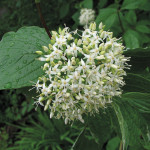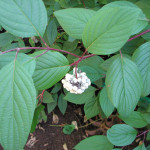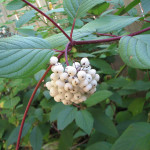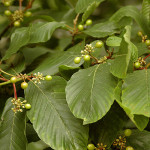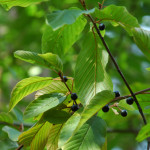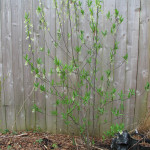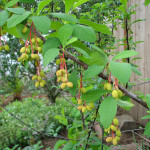Cornus sericea
Red osier dogwood (Cornus sericea) is a medium to tall deciduous shrub. It can grow 6-15 feet tall and 5-10 feet wide depending on site conditions, and spreads to form dense thickets. It is attractive year round with red winter twigs (especially in sunny sites), creamy-white flower clusters, red to purple fall color, and bluish-green to white fruits.
This shrub is excellent for wildlife. Painted lady butterflies visit the flowers for nectar, and spring azure butterflies lay their eggs on the newly developing leaves and buds. Dozens of species of birds and mammals rely on it for food year-round, eating the new shoots in the spring, berries in summer and fall, and twigs through the winter. Birds take cover and nest in the shrubs, and even some amphibians lay more eggs in wetlands with red osier dogwoods than without.
Cuttings readily root, and it is an excellent shrub for improving the health of stream banks and wetlands. In the wild, it commonly grows in wetlands and other habitats with damp soil.
- Light Requirements: Full Sun, Part Shade
- Water Requirements: Moist, Seasonally Wet, Perennially Wet
- Ease of Growing: Easy to grow
- Growth Rate: Fast
- Spreads: Yes
- Wildlife Support: Pollinators, Hummingbirds, Birds or Mammals
- Fire-resistant: Yes
- Edible: No
- Mature Height: 15ft
- Mature Width:6-9ft
Cascara

Frangula purshiana
Cascara (Frangula purshiana) is found along the Pacific coast from British Columbia to northern California along riverbanks and in other moist locations.
A hardy, compact, attractive tree, it is often planted in Portland’s parking strips. In the spring it produces clusters of small, green-white flowers. In late autumn, the leaves turn a delicate yellow and persist through many a winter storm.
The flowers attract many pollinators in early summer such as Lorquin’s admiral butterflies. Pale swallowtail butterflies lay their eggs on the leaves. Birds enjoy the fruit, but they are toxic to humans and should be avoided.
- Light Requirements: Part Shade, Full Shade
- Water Requirements: Moist, Seasonally Wet
- Ease of Growing: Easy to grow
- Growth Rate: Slow
- Spreads: No
- Wildlife Support: Pollinators, Birds or Mammals
- Fire-resistant: Yes
- Edible: No
- Mature Height: 30ft
- Mature Width:20ft
Osoberry
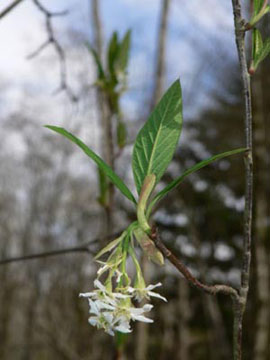
Oemleria cerasiformis
Osoberry is a fast-growing, multi-stemmed shrub to small tree with reddish to purplish-brown bark. In open sunny locations it may form a dense shrub, while in the shade it becomes more open to sprawling. This is one of our earliest flowering native shrubs, and its slender, lime-green leaves are one of the first signs that spring is on the way!
This woodland plant does best in moist areas with dappled shade, and can tolerate many soil types, including heavy clay.
In the early spring, both male and female osoberries produce dangling clumps of whitish flowers. Female plants will then produce small hard berries towards the end of summer (male plants produce no fruit). The fruit is peach-colored early in the season, maturing to blue-black in the fall, and is a favorite of many birds and small mammals. Osoberry also serves as a host for several caterpillar species, and the flowers are a source of nectar for butterflies, hummingbirds, and pollinators, making this an excellent wildlife plant.
- Light Requirements: Full Sun, Part Shade, Full Shade
- Water Requirements: Dry, Moist
- Ease of Growing: Easy to grow
- Growth Rate: Fast
- Spreads: No
- Wildlife Support: Birds or Mammals
- Fire-resistant: Yes
- Edible: Yes
- Mature Height: 15ft
- Mature Width:5-10ft
Blue Elderberry

Sambucus cerulea
Blue elderberry (Sambucus cerulea) is a large, fast-growing deciduous shrub or small tree featuring showy clusters of creamy-white flowers that mature into large clusters of blue-black berries.
This shrub is a great addition to your wildlife garden. Many birds eat the berries, and butterflies visit the flowers for nectar. The plant provides food for the young of spring azure butterflies and various moths. Native solitary bees shelter and lay their eggs in the hollow twigs. Dead elder wood is also the preferred habitat of the mushroom Auricularia auricula-judae, also known as Judas’ ear fungus or wood ear fungus.
Blue elderberry can get quite tall, reaching up to 15 feet in height. Plant it in sun to part shade in well drained soils.
- Light Requirements: Full Sun, Part Shade
- Water Requirements: Dry, Moist
- Ease of Growing: Easy to grow
- Growth Rate: Fast
- Spreads: No
- Wildlife Support: Pollinators, Pest-eating Insects, Birds or Mammals
- Fire-resistant: Yes
- Edible: Yes, but parts of the plant toxic
- Mature Height: 10-25ft
- Mature Width:18ft


